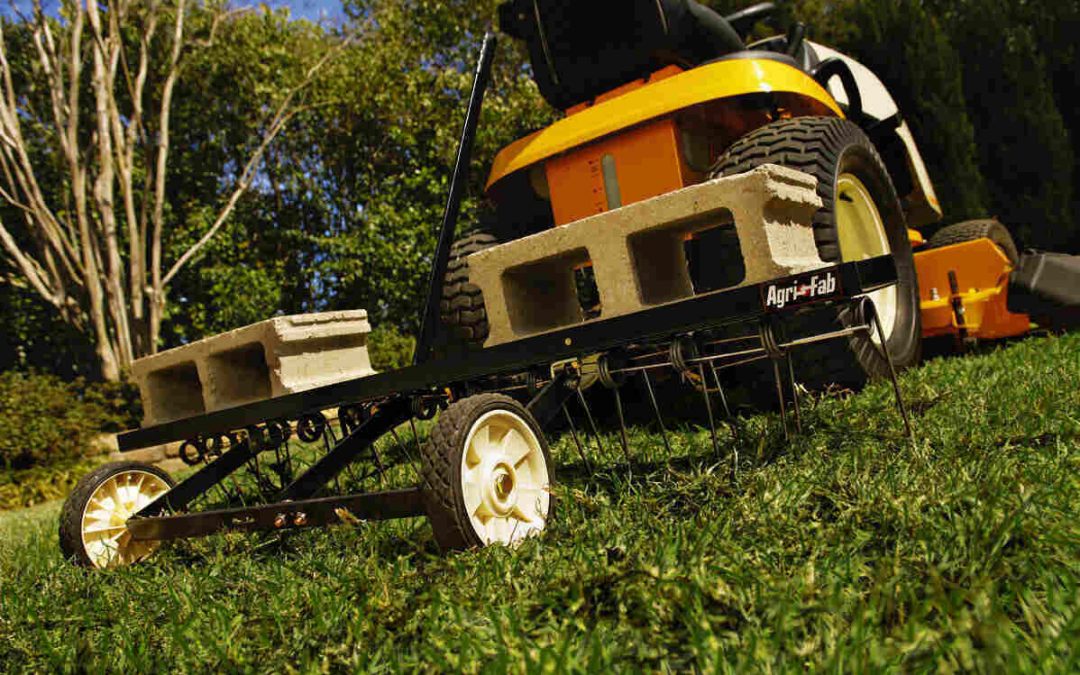Are you finding clumps of dead grass and debris in your lawn? We’ll teach you how to dethatch your lawn to keep your grass green all season long. This guide contains everything you need to ensure your lawn remains thatch free.
Contents:
What is Thatch
Thatch is a combination of dead and living material that forms from dead stems, mulch, and plant material and clumps together over time. These clumps usually appear as thick patches on the surface of your lawn.
Thatch has adverse effects on your lawn, attracting pests and harmful bacteria, making your yard less drought-tolerant over time.
How To Dethatch Your Lawn
1. Use a Power Rake
Power rakes are effective tools for dethatching small lawns. Use a rake with rotating wire tines to cut through clumps of grass.
- Locate the thatch on your lawn that you want to pull out.
- Push your rake into the grass as far as it will allow.
- Pull the dethatching rake from the grass, releasing thatch and grassy clumps.
2. Use a Mower
For larger lawns with a thick layer of thatch, it’s better to use a mower. Vertical mowers contain blades that are perpendicular to the grass. The verticutter will rip through thatch as you go without damaging the grass blades, minimizing the presence of thatch on your lawn.
- Let your mower slowly pass over the affected grass.
- Repeat as many times as necessary over the affected areas. It’s better to go back over the same patch of grass and make the grass shallower over time than to mow it too short in one pass.
- Make sure not to cut too deep into the grass.
You may need to trim your yard down further than you were expecting. If that’s the case, you’ll need to overseed your grass to make up for the thin layer of grass left behind.
3. Core aeration
Aeration is an essential part of lawn maintenance. Aerators dig holes into your soil, allowing your grass to breathe. Aerating your lawn reduces clumping and minimizes the presence of thatch.
4. Liquid dethatchers
Liquid dethatchers such as Nature’s Biological Dethatcher are easy to use. Simply apply the solution to the surface of your lawn, and it will break up thatch over time.
5. Topdress your lawn
Add compost or soil over the top of your yard to break down thatch over time and revitalize your grass.
6. Use a Trowel
Trowels are small hand tools you can use to dig out the thatch. They’re best for small amounts of thatch and soil buildup.
Ways to Prevent Thatch
You can save yourself time and work by preventing thatch before it occurs.
1. Monitor soil levels: Test your soil frequently for changes in the pH and alkaline levels. High pH levels are often telltale signs of excessive thatch.
2. Sensible fertilization: It can be easy for an aspiring green thumb to over-fertilize their lawn. Only use as much fertilizer as you need for a healthy lawn and limit the use of nitrogen-based lawn fertilizers.
3. Reduce chemical Use: Using too many chemicals like bug spray can kill the earthworms that naturally control soil compaction. Try to limit the number of chemicals you use on your lawn.
4. Water regularly: A well-hydrated lawn prevents soil compaction, which leads to thatch.
5. Maintaining a regular lawn care routine: Make sure to mow your lawn regularly and use weed killer to eliminate weeds that can lead to thatch.
What Causes Thatch
One of the main causes of thatch build-up is over-fertilization. Too much nitrogen causes the grass to grow too quickly, often resulting in thatch.
The type of grass in your yard may be a factor too. Some grasses are more prone to thatching, including Kentucky bluegrass, zoysiagrass, creeping red fescue, and creeping bentgrass.
Dethatching your lawn is a straightforward process and will help promote the overall growth of your lawn. Make sure to include dethatching in your seasonal landscaping routine.
FAQs About Thatch
1. Which grass types don’t produce as much thatch build-up?
Perennial ryegrass and tall fescue tend to bunch up and don’t produce much thatch.
2. Do grass clippings produce thatch?
No. Contrary to popular belief, grass clippings do not cause thatch to accumulate on your lawn. In fact, the grass clippings are an excellent fertilizer and will prevent thatch because you won’t have to use a nitrogen-based fertilizer.
3. When should I remove thatch?
Remove thatch in the cooler months; late spring for warm-season grasses, early spring or late fall for cool-season grass types. Avoid removing thatch when your grass isn’t healthy, such as during a drought, as this can cause lasting damage to the turf.
4. Are there certain chemicals to avoid to reduce thatch?
Yes. Fungicides, pesticides, and insecticides have a detrimental effect on your lawn. They kill microorganisms and earthworms and can promote thatch.
Not up for DIY lawn work? We can help you find a lawn care pro near you to dethatch, aerate, and mow your lawn, so you’ll have more time to enjoy it.

